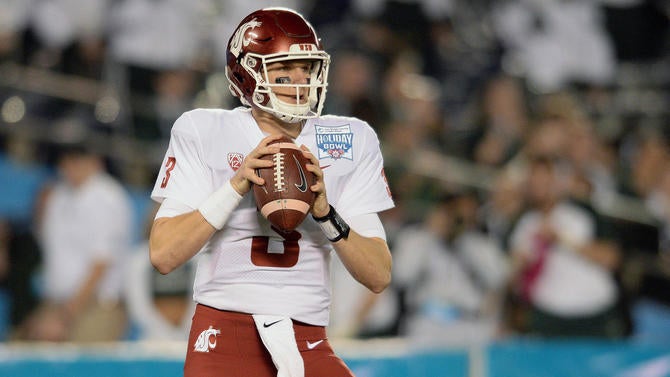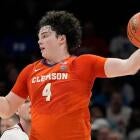
There will be no moment of silence for Tyler Hilinski before Washington State's opener next week against Wyoming.
His locker will not be encased in glass as a tribute to the 21-year-old quarterback who died of suicide on Jan. 16.
At last month's Pac-12 Media Day, reporters were encouraged not to ask participating Wazzu players pointed questions about their former teammate.
In fact, the less said about the suicide, the better, according to many Washington State officials.
"This has come up in the aftermath of Tyler's death … overly memorializing someone," said Dr. Victor Schwartz, a New York University School of Medicine psychiatrist advising the university. "Drawing too much attention in a way that appears honoring the person that died or giving them a lot of attention."
Not talking about Hilinski is part of the plan. His death has become a case study in how to deal with suicide on a mass scale.
It's not just a question of the football team recovering. Washington State is a campus of 30,000 students in isolated Pullman, Washington.
In June, the Center for Disease Control said suicide rates are up in every state except Nevada. Suicide is the 10th-leading cause of death.
Modern recovery after such a tragedy, according to those same professionals, includes buzzwords like "clusters" and "contagion."
Yes, they're worried there may be copycat suicides on the Pullman campus. It nationally happened in 2014 when Robin Williams died of suicide, according to Dr. Sunday Henry, director of athletic medicine at Washington State.
"An uptick in even that method of suicide," she said.
After Williams died by suffocation, the rate of death by that means rose 32.3 percent, according to a report.
That copycat factor remains a concern at Washington State.
"To my knowledge, there has been one other death by suicide," Henry said. "Our concern is that might possibly be the case. I know that this other person did die. It was after the end of the semester."
The Whitman County Coroner's Office did not immediately return a call seeking comment.
Washington State has been credited for mobilizing counseling resources quickly after Hilinski's death. The school partnered with the JED Foundation, a non-profit that specializes in suicide prevention in young adults. A large part of the JED message: honor but move on.
"We have very fond memories of Tyler," coach Mike Leach said. "We're proud to have the opportunity to know him. Also, he would want us to move on and have productive lives."
That's why there will not be that moment of silence a week from Saturday at Martin Stadium. Instead, Hilinski's parents have been invited to raise the Cougar flag before the game.
The death has not only been a main topic of conversation in Pullman; it has been one of the most significant stories of the offseason.
All accounts suggest Hilinski was sociable, outgoing and well-liked by his teammates.
"There were no signs," said Mary Jo Gonzales, Washington State vice president of student affairs.
"There is a potential problem," Schwartz said, "with the kids continuing to focus and memorialize Tyler."
As insensitive as it might sound, the approach to recovery is common. Suicide rates have risen 30 percent in the U.S. since 1999. That qualifies as a national crisis, according to professionals.
Contagion -- those copycat suicides -- "are a real concern," Schwartz said. "Some of the circumstances that make the risk greater is close proximity. The more you feel a kind of connection or kinship with the person, the more risk there can be."
That contagion is real. Between 2013-17, 14 students at Penn died by suicide. There were six suicides at Cornell during the 2009-10 academic year.
"When I wake up in the morning, I wonder, 'What other clusters am I not seeing?'" Gonzales said.
What is there to do about it?
The Washington State campus is one of the most isolated in the country: 80 miles south of Spokane, it revels in its underdog rep against the bigger Pac-12 schools.
Hilinski was one of those underdogs. He backed up future NFL quarterback Luke Falk. In the second game of 2017, Hilinski came off the bench to complete 25-of-33 passes in a three-overtime win against Boise State. He threw the winning touchdown pass.
"Shoot, I was just playing football out there," Hilinski told reporters, "surrounded by a great group of guys."
It's those kinds of tragic/fuzzy memories that linger over the cozy Wazzu campus.
"Unfortunately, we had suicides before Tyler. We had suicides after Tyler," Gonzales said. "We're not trying to diminish the loss to the family. It's about making sure our students understand the resources available. 'I need help,' are some of the hardest words for this age group [to say]."
Gonzales is as invested as anyone at Washington State. She was 17 when her sister Roberta killed herself in 1985.
"She was a junior college softball player in California," Gonzales said. "She had blown out her knee and was pretty much told she wasn't going to play anymore.
"That question, 'Why?' haunts every one of us. The haunts get better over time. My sister Roberta never got to have children. The 'Why?' for me has become why I do what I do."
A 2015 study revealed that, while NCAA athlete suicide rates are lower than the general population at a similar age, football players are most at risk.
It's a delicate balance between memorializing a former athlete and over-memorializing a former athlete.
"The other students that did commit suicide this year, their families did not get the attention [of Hilinski]," Gonzales said.
Again, that comment should be regarded as clinical, not critical. The idea is for families to shield from reliving the tragedy.
Henry referred to the cluster of celebrities who died of suicide within a two-day period in June -- Kate Spade and Anthony Bourdain.
"It's very hard when a celebrity like that dies," she said. "People are going to report on it. That's exactly what we're trying to avoid. Someone in that [suicidal] place sees that person getting a lot of attention, positively. Then they think that is a viable option for them. These 15- to 25-year-old brains aren't developed like your brain and my brain from a frontal lobe concept. They're more impulsive."
Gonzales added that some Cougars' players have chosen to get a "3" tattoo (Hilinski's number).
"There are other players who are like, 'I don't even want to see the No. 3 anymore,'" she said. "Other students were saying, 'I am ready to move on.' … We have to think about the 30,000 students in this conversation."
The most revealing look at the suicide came this June in a Sports Illustrated story. The report included graphic descriptions of Hilinski's suicide process.
"I was not happy with the article," Henry said. "In terms of everything I'm trying to promote here, it went back and relived that entire thing in great detail."
But to criticize the story criticizes part of the process: All feelings are valid at this point. The Hilinski family cooperated with SI. They voiced concerns about Tyler's brain reportedly being afflicted with Stage 1 CTE.
The story publicized their new Hilinski's Hope Foundation.
"There are some who want to elevate Tyler," Gonzales said. "That's their right to do so. We don't want anything else to happen to Tyler. What I would say is, all of our students matter."
![[object Object] Logo](https://sportshub.cbsistatic.com/i/2020/04/22/e9ceb731-8b3f-4c60-98fe-090ab66a2997/screen-shot-2020-04-22-at-11-04-56-am.png)


















